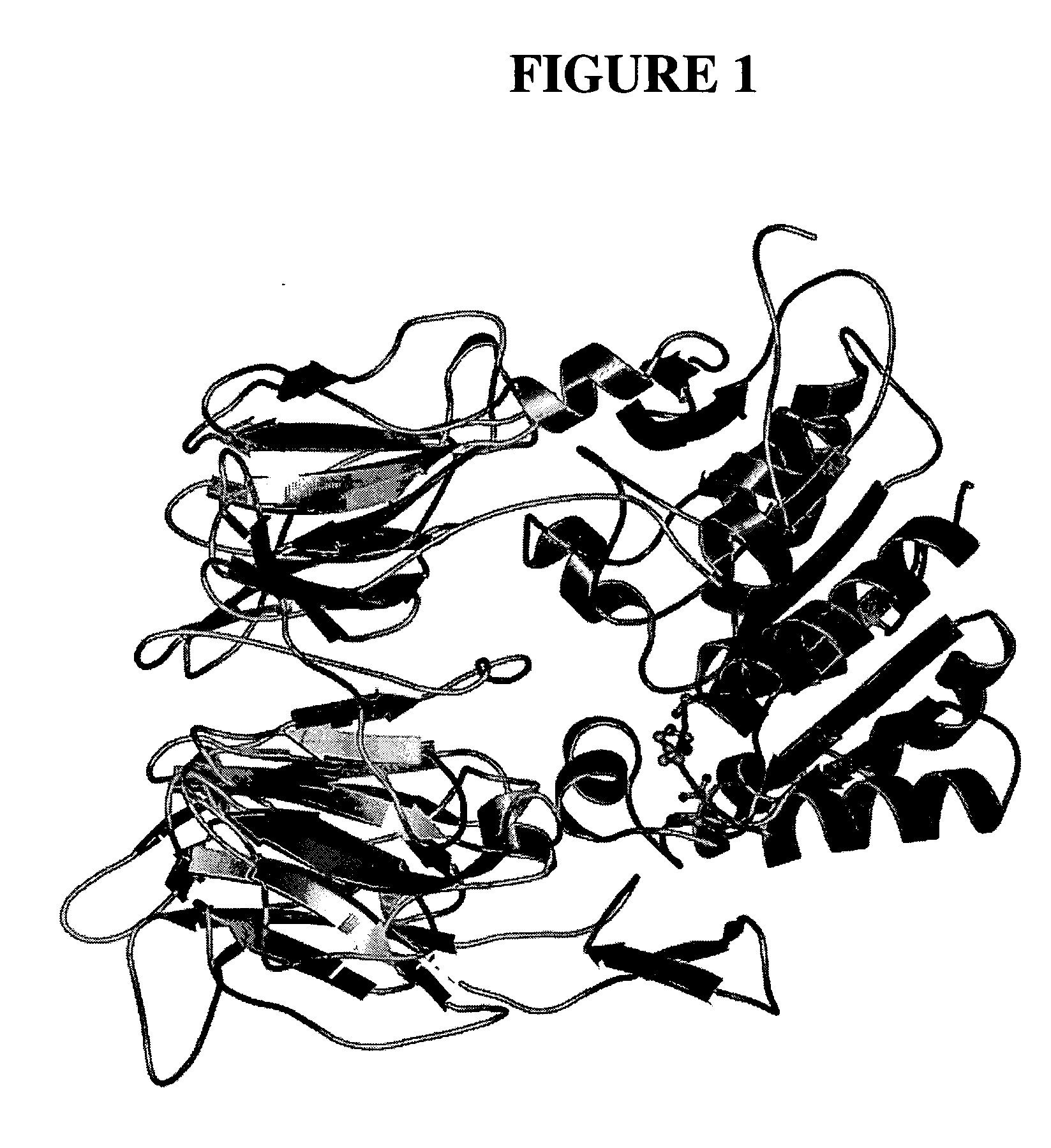Dipeptidyl peptidase inhibitors
a technology of peptide inhibitors and peptides, which is applied in the field of dipeptidyl peptidase inhibitors, can solve the problems of short half-life of glp-1 (7-36), infertility and amenorrhea, and rapid degradation of glp-1 in vivo
- Summary
- Abstract
- Description
- Claims
- Application Information
AI Technical Summary
Benefits of technology
Problems solved by technology
Method used
Image
Examples
example 1a
5-Bromo-2-chloro-3H-pyrimidin-4-one
5-Bromo-2,4-dichloro-pyrimidine (5.0 g, 22 mmol) was stirred in THF (10 mL) with 1N NaOH (30 mL) at r.t. for 3h. The solution was made slightly acidic with 1N HCl and was extracted with CHCl3. Organics were dried (MgSO4) and concentrated in vacuo. Precipitation from 20% CHCl3 / hexanes and collection by filtration gave 2.92 g (64%) of 5-bromo-2-chloro-3H-pyrimidin-4-one as a white solid. 1H NMR (400 MHz, DMSO-d6): δ13.33 (br s, 1H), 8.35 (s, 1H). MS (ES) [m+H] calc'd for C4H2N2OBrCl, 209, 211, 213; found 209, 211, 213.
example 1b
2-(5-Bromo-2-chloro-6-oxo-6H-pyrimidin-1-ylmethyl)-benzonitrile
5-Bromo-2-chloro-3H-pyrimidin-4-one (1.88 g, 9.0 mmol) was stirred in DME (25 mL) / DMF (5 mL) under nitrogen at 0° C. Sodium hydride (95%, 238 mg, 9.4 mmol) was added in portions. After 10 min, lithium bromide (1.56 g, 17.9 mmol) was added and the reaction stirred for 15 min at r.t. α-Bromo-o-tolunitrile (3.5 g, 17.9 mmol) was added, and the reaction stirred at 65° C. for 8 h. The solution was diluted with EtOAc, washed with brine, dried (MgSO4) and concentrated in vacuo. Purification by silica gel chromatography (1:1:1 EtOAc / hexanes / CHCl3) gave 997 mg (34%) of 2-(5-bromo-2-chloro-6-oxo-6H-pyrimidin-1-ylmethyl)-benzonitrile as a white solid. 1H NMR (400 MHz, CDCl3): δ8.11 (s, 1H), 7.73 (dd, 1H, J=7.6, 1.2 Hz), 7.58 (dt, 1H, J=7.6, 1.2 Hz), 7.45 (t, 1H, J=7.6 Hz), 7.16 (d, 1H, J=7.6 Hz), 5.69 (s, 2H). MS (ES) [m+H] calc'd for C12H7N3OBrCl, 324, 326, 328; found 324, 326, 328.
Also obtained from the reaction were impure f...
example 1
2-[2-(3-(R)-Amino-piperidin-1-yl)-5-bromo-6-oxo-6H-pyrimidin-1-ylmethyl]-benzonitrile, TFA salt
2-(5-Bromo-2-chloro-6-oxo-6H-pyrimidin-1-ylmethyl)-benzonitrile (189 mg, 0.58 mmol), (R)-3-amino-piperidine, dihydrochloride (128 mg,0.74 mmol) and sodiumbicarbonate (195 mg, 2.32 mmol) were stirred in ethanol (5 mL) at 60° C. for 90 min. The reaction was diluted with EtOAc, washed with water and brine, dried (MgSO4), and concentrated in vacuo. Purification by silica gel chromatography (5% MeOH / CHCl3) gave 139 mg (62%) of the title compound as a clear oil. This was converted to the solid TFA salt by subjection to TFA in CH2Cl2 and concentration in vacuo. 1H NMR (400 MHz, DMSO-d6): δ8.18 (s, 1H), 7.98 (br s, 3H), 7.82 (d, 1H, J=6.8 Hz), 7.64 (dt, 1H, J=7.6, 1.2 Hz), 7.47 (t, 1H, J=7.2 Hz), 7.27 (d, 1H, J=7.6 Hz), 5.29 (AM q, 2H, J=42.8, 15.2 Hz), 3.52-3.57 (m, 1H), 3.30-3.39 (m, 1H), 3.15-3.24 (m, 1H), 2.88-3.05 (m, 2H), 1.90-1.99 (m, 1H), 1.75-1.83 (m, 1H), 1.49-1.63 (m, 2H). MS (ES) [m+...
PUM
| Property | Measurement | Unit |
|---|---|---|
| stereoisomers | aaaaa | aaaaa |
| stereoisomer | aaaaa | aaaaa |
| amino-acid | aaaaa | aaaaa |
Abstract
Description
Claims
Application Information
 Login to View More
Login to View More - R&D
- Intellectual Property
- Life Sciences
- Materials
- Tech Scout
- Unparalleled Data Quality
- Higher Quality Content
- 60% Fewer Hallucinations
Browse by: Latest US Patents, China's latest patents, Technical Efficacy Thesaurus, Application Domain, Technology Topic, Popular Technical Reports.
© 2025 PatSnap. All rights reserved.Legal|Privacy policy|Modern Slavery Act Transparency Statement|Sitemap|About US| Contact US: help@patsnap.com



